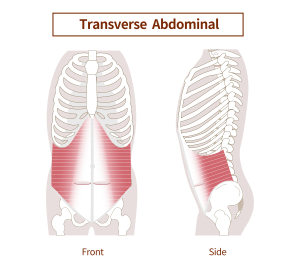The birth of a child is one of the most remarkable experiences in a woman’s life. However, alongside the joy of welcoming a new family member, pregnancy also brings numerous changes to the body. One significant change involves muscle control, particularly the deep abdominal muscle (Transversus Abdominis), and how the brain regulates it. This comprehensive article explores the rewiring process after birth and the relationship between the brain and the Transversus Abdominis. It also provides guidance on how to train and activate this deep abdominal muscle immediately after childbirth.

The Impact of Pregnancy on Abdominal Muscles
During pregnancy, the abdominal muscles are greatly stretched
During the nine months of pregnancy, the female body undergoes numerous changes. The uterus grows, the baby’s weight increases, and hormonal changes affect the entire organism. These changes also impact muscle control, particularly the M. Transversus abdominis, an important abdominal muscle located deep in the trunk that is responsible for body stability. Unlike the superficial abdominal muscles often trained with conventional crunches, the M. Transversus abdominis lies deeper and forms an inner belt around the waist. This is why it is also called the corset muscle.
A detailed look at the abdominal muscles
The abdominal muscles, often simply referred to as “abs,” play a crucial role in supporting the trunk, enabling movements, and holding the internal organs in place by regulating intra-abdominal pressure. These muscles are essential for maintaining posture and are divided into several groups:

Abdominal Muscles
- Rectus Abdominis (Straight Abdominal Muscle)
- The rectus abdominis is the most well-known abdominal muscle, often associated with a “six-pack.” This paired muscle runs vertically on each side of the anterior abdominal wall. It is segmented by the linea alba (a connective tissue seam) and three horizontal tendinous intersections, giving it its characteristic appearance.
- Function: Bends the lumbar spine, brings the ribcage closer to the pelvis.
- External Oblique (External Oblique Abdominal Muscle)
- The external obliques are the largest and most superficial of the three flat abdominal muscles. These muscles are located on the sides and front of the abdomen.
- Function: Allows for trunk rotation (contralateral rotation).
- Internal Oblique (Internal Oblique Abdominal Muscle)
- The internal obliques lie directly beneath the external obliques and run perpendicular to them. These muscles are smaller and deeper.
- Function: Rotates the trunk (ipsilateral rotation).
- Transversus Abdominis (Transverse Abdominal Muscle)

- The transversus abdominis is the deepest of the abdominal muscles and wraps around the trunk like a corset.
- Function: Provides stability for the spine and pelvis.
Inhibition of voluntary muscle control during pregnancy
This is due to a combination of various factors occurring during this period.
- Hormonal Changes: During pregnancy, women experience an increase in certain hormones like progesterone and relaxin. These hormones not only affect tissue elasticity but can also influence nerve conductivity. Increased production of relaxin can impair muscle control, making it difficult to activate the Musculus Transversus.
- Changes in Body Weight: The growing uterus and additional baby weight shift the body’s center of gravity forward, increasing pressure on the abdominal muscles. This can hinder the voluntary activation of the Musculus Transversus due to stress and changes in the abdominal area.
- Stretching of the Abdominal Muscles: During pregnancy, the abdominal muscles stretch significantly to accommodate the growing fetus. This stretching can weaken the muscles and impair the ability to voluntarily activate the Musculus Transversus.
- Changes in Posture: Many women experience changes in their posture during pregnancy to compensate for the extra weight and carry the growing belly. These changes can affect how the trunk muscles, including the Musculus Transversus, are activated.
Learn to reactivate the deep abdominal muscle (transversus abdominis) after pregnancy
The reconnection phase after birth is crucial for restoring and strengthening the connection between the brain and the deep abdominal muscle (Musculus Transversus abdominis).
In the post-birth reconnection phase, the brain learns to efficiently control the muscle groups, including the deep abdominal muscle and the pelvic floor. This process requires time and practice, as the brain must re-establish muscle control. Targeted exercises and conscious attention to muscle activation can accelerate this process.
By specifically training this corset muscle, we can not only strengthen the abdominal muscles but also make the waist appear slimmer.
How can I relearn to activate the transverse abdominal muscle and the pelvic floor?
The most important thing is to start a few days after birth, as soon as you feel fit again, by consciously exhaling while lying down and drawing in the navel.
- Simply by exhaling, the deep abdominal muscle is activated, and by drawing in the navel, the brain can relearn how to activate the transverse abdominal muscle.
- Initially, you might not feel anything when you draw in your navel, which is normal. It is crucial to persist. Daily, whenever you remember, firmly draw in your navel while exhaling. Whether lying down, sitting, breastfeeding/feeding… It might take weeks or months before you feel your abdomen again when drawing in the navel. But it is very important to persist and draw in the navel as often as possible.
- Ideally, you should activate the transverse abdominal muscle together with the pelvic floor. These two muscles are closely connected. Additionally, they are closely linked with the diaphragm, so it is also beneficial to focus on breathing. During tension exercises, it is ideal to exhale.
Drawing in the navel trains the Musculus Transversus (deep transverse abdominal muscle) and helps regain a flat belly!

Simply by starting as soon as possible after pregnancy to draw in the navel firmly and as often as possible and activating the pelvic floor, the brain first relearns how to activate the deep transverse abdominal muscle and then train it. When tensed, the muscle encloses the abdominal organs and holds them in place like a corset. This is very important to avoid subsequent conditions such as incontinence or back problems.
Deep abdominal muscle exercises right after birth: The best exercises for a flat belly
The most effective exercises to strengthen the transverse abdominal muscles are:
- Breathing Exercises
- How to do it: Lie on your back or sit comfortably. Place one hand on your chest and the other on your abdomen. Take a deep breath in, letting your abdomen expand while keeping your chest still. Exhale slowly. Benefits: Promotes relaxation and activates the diaphragm and deep abdominal muscles.
- Pelvic Tilt
- How to do it: Lie on your back with your knees bent and feet flat on the floor. Slowly exhale and pull your belly button towards your spine, pressing your lower back into the floor and tilting your pelvis. Benefits: Strengthens the lower abdominal muscles and relieves lower back tension.
- Activate the Transversus Abdominis
- How to do it: Sit or lie on your back with your knees bent and feet flat on the floor. Place your hand beside your abdomen and take a deep breath in. As you exhale, pull your belly button towards your spine and feel your abdominal muscles engage. Benefits: Strengthens the deepest layer of abdominal muscles.
- Vacuum Exercise
- How to do it: Stand upright and exhale completely. Then, pull your belly button in as far as possible, as if you are trying to pull it towards your spine. Hold this contraction for 10-20 seconds, then relax. Repeat several times. Benefits: Strengthens the deep abdominal muscles and improves core stability.
- Pelvic Floor Contractions (Kegels)
- How to do it: Sit or lie down comfortably. Tighten your pelvic floor muscles as if you are trying to stop the flow of urine. Hold for a few seconds, then release. Benefits: Strengthens the pelvic floor muscles, which are especially important after childbirth.
- Pelvic Movements
- How to do it: Lie on your back with your knees bent and feet flat on the floor. Gently tilt your pelvis upward, pressing your lower back into the floor. Hold for a few seconds, then release. Benefits: Strengthens the lower abdominal muscles and relieves lower back tension.
- Heel Slides
- How to do it: Lie on your back with your knees bent and feet flat on the floor. Slowly slide one heel away from your body until your leg is straight, then slide it back. Alternate legs. Benefits: Gently activates the lower abdominal muscles.
- Bridge
- How to do it: Lie on your back with your knees bent and feet flat on the floor. Lift your pelvis to form a straight line from your knees to your shoulders. Hold for a few seconds, then lower slowly. Benefits: Strengthens the glutes, lower back, and deep abdominal muscles.
These exercises may seem very simple and like they won’t help much. However, they are very effective. Practice for 4 weeks – keep drawing in your navel firmly and hold the tension for several seconds throughout the day. After 4 weeks, you will likely see significant results!
At the same time, these exercises are also the first step in closing a diastasis recti.
For a comprehensive guide on postpartum recovery exercises, you can find detailed instructions in the article Postpartum recovery exercises.
The articles on health topics do not replace a visit to the doctor. You can find more information here.

Sonja ist Ernährungswissenschaftlerin und promovierte Epidemiologin mit langjähriger Erfahrung in der Gesundheitsforschung. Seit der Geburt ihrer beiden Kinder 2019 und 2023 beschäftigt sie sich intensiv mit dem Thema Rückbildung und der Thematik, wie man wieder einen gesunden und schönen Körper mit stabiler Mitte nach der Schwangerschaft bekommen kann. Sie möchte Euch helfen, nach der Schwangerschaft wieder fit zu werden!
